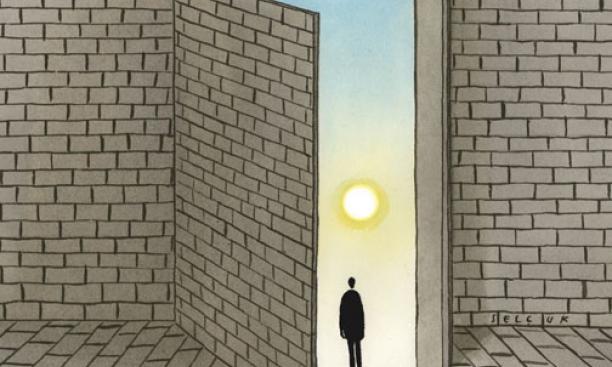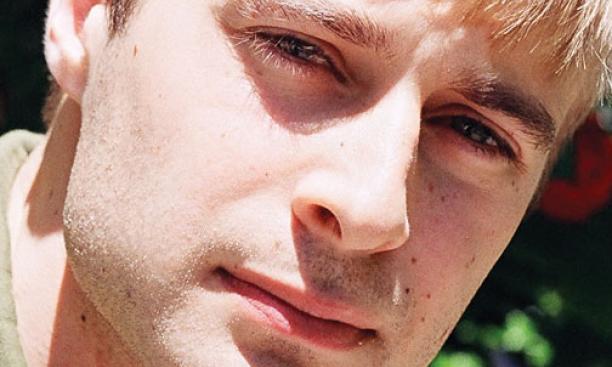

(Editor's note: The following is a revised version of the story published in the Oct. 24, 2012, issue of PAW.)
Garden State Youth Correctional Facility hangs low on the horizon, a long squat building on a poor, semi-rural plain south of Trenton. A watchtower and a barbed-wire fence veil its elongated southern face; to the east a parking lot, a flagpole, and a rounded, functionalist office pavilion give off an air of depressed normalcy. Its nearest neighbors are a desolate strip mall, a lone silo in a field, a grim-looking high school, and its older sibling, the A.C. Wagner Youth Correctional Facility.
The prison is a place apart. It is not squalid or superficially wretched; not openly paranoid or sadistic; not rigidly, inhumanly institutional. Its defining feature is rather its separateness. The parking lot is quiet except for the hum of an officer’s pickup truck. The sunset above is a fierce stain on the translucent sky, beautiful but almost unrecognizable, as if emanating from an alien star. The cause, I think, is pollution.
Once a week I travel to this place with a few colleagues to teach. Not much comes through the metal detector and the first electric gate. Car keys and drivers’ licenses are allowed in; wallets, cell phones, and most kinds of jewelry are not. We teachers are allowed to go through, but only after we’ve been cleared by the Department of Corrections, given thorough background checks, and sworn to obey the rules. Books come through, too, once they’ve been X-rayed: the preacher’s Bible and the instructor’s stack of banal challenges — workbooks, notebooks, paper, photocopies, class materials. My book bags feel grave and serene in my hands as I pick them up from the X-ray belt. The channels of entrance to this world are narrow. But the articles and stories and fussy writing rubrics I teach at Garden State go inside and travel freely. Ideas are restless; they cut a road for themselves.
Garden State is one of the four prisons where members of the Princeton community — mostly graduate students, as well as postdocs, faculty, and administrators — teach courses through the University’s Prison Teaching Initiative (PTI). The program was founded six years ago by Mark Krumholz ’98, a postdoc in astrophysics who had taught math at a California prison while a graduate student at Berkeley. His first class at Garden State, “Intermediate Algebra with Applied Concepts,” had eight students. Last year, PTI offered 25 classes to 269 students. Courses included introductory and advanced English; several levels of algebra; introductory courses in biology, philosophy, and sociology; and an advanced elective in lyric poetry. The courses are accredited by Mercer County Community College, and they count toward an associate’s degree or, if used to transfer to one of the Rutgers University campuses, toward a bachelor’s. More than 600 students have passed through our classes; 14 are now enrolled at Rutgers, and many more at community colleges.
The 65 to 70 regular teachers come from 18 Princeton academic departments, the University library, and the Institute for Advanced Study. Because the prison students receive college credit, undergraduates cannot teach classes but work as tutors and teaching assistants.
I teach English 101. I usually begin a semester with about 30 students; I usually finish with 15 or 20. The high attrition rate is the clearest indicator of the volatility of the inside world: One day a student is in his usual seat, participating, completing assignments, coming to worry me about grades or an extension, and the next he is gone. There is never a word from the prison as to what has happened, but gradually a story emerges from the other students: sent to solitary, transferred to another prison, education privileges revoked. Rules, actions, consequences — these are constantly in play, far outside my awareness, in the building where twice a week I teach.
My students, all men between the ages of 18 and 30, are by turns sweet and abrasive, disarmingly honest and unexpectedly cunning, worried about their grades and frustrated by uninteresting assignments. In short, they are 15 splendid human consciousnesses, veiled from a teacher’s prying eye by a great many masks. Trying to imagine what it is that goes on behind each pair of eyes, trying to anticipate, coax, and exhume what skills or ideas might be biding their time there, is the marvelous and excruciating task of every teacher. Its difficulty here is compounded by the fact that these students, dressed identically in khaki and thermals, often have lived a long life’s worth of anguish in a few years.
Many of my students left the public school system in early adolescence and have been schooled in juvenile halls, county jails, state prisons, and, when not confined to an institution, on the street. Some are voracious intellectuals; others are afraid of reading aloud. None has patience for pious teacherly bullshit. Questions in my classroom are frank and without pretense or protocol. If he wrote a sonnet to a man, does that make Shakespeare gay (a gentler word than my students often use)? If he is so critical in his writing, does that mean James Baldwin hates white people? Why are black people poor? Why are white people rich? Why are we reading so many black writers? Do you think we can’t read white literature? Why aren’t we reading more black writers? In my fumbling for answers I realize that much of my own experience in teaching and learning has been a matter of etiquette: learning niceties, ways of phrasing and rephrasing, of dancing around questions with smaller observations, buying the time needed to build an answer by stringing together empty preambles or using, even in today’s supposedly liberated environment, an endless string of euphemisms.
The language in prison is always honest, even if it’s not respectful or always true. Ross Lerner, a graduate student in English and a fellow teacher, has observed that experience is the only primary source in the prison — and when I say “honest,” I mean that language is shaped directly from that experience. It is harsh, and so is the honesty hewn from it. Even for those students who read or daydream or get regular letters from loved ones, the fact of prison fills the basin of reality almost to the brim, and it drowns many layers of nuance. The harshness, broad strokes, and intolerance that accompany some of my students’ interactions with me come in large measure from the unending powerlessness that is the condition of life in a prison — even in a comparatively humane one like Garden State. Everything is inflected with the touch of power: masculinity, sexuality, rudeness, politeness, conversation, silence, eating, dressing, facial hair, sanitation, and, of course, physical contact of any kind. The work of power is in some considerable measure beyond the control of even well-intentioned guards, staff, and — it must be added — teachers.
Inmates have methods for preserving their dignity and independence. Many turn to religion. One of my students was a theologian, schooled in Plotinus, Augustine, and Platonic mysticism. Another, at the opposite end of the spectrum, kept a list of the logical fallacies in his head (ad hominem, ad absurdum, tu quoque, gambler’s fallacy, no true Scotsman) — I suppose as a reminder of his continued capacity for reasoning. One student who was released last semester had taught himself to write in an exquisite gothic script. And my most good-humored student told me once, almost as a challenge, that he was a writer. When I asked to see his writing, he brought in three composition notebooks, filled across every page with poetry. His inspirations, he explained, included Jay-Z and Jean-Michel Basquiat. “You do know who Basquiat is, don’t you?” he asked me warily.
I am an English teacher, and so I usually notice the students who affirm their presence in the world through writing. But I don’t doubt that similar acts of self-understanding (and as many acts of self-deception) go on in other realms: among inmates studying math, science, business administration, or religion, or those who do their time without access to teachers or social workers, as is the case for the vast majority.
Education is not the only avenue toward recovering and protecting one’s dignity in prison, but it is a major one. Done right, it offers a modicum of the authority required of a person for self-creation: It makes a person in some modest way master of his or her own mind. And, more directly relevant to the situation of inmates, it offers the strongest defense against the penetrating force of shame, the most dangerous and insidious presence in the American prison system. Felons in our society are branded, not on the skin anymore, but on paper and in databases, their names and numbers making many of them ineligible to vote, sit on juries, find jobs, live in public housing, or use food stamps. This state of being marked forever and always begins in the prison and endures once the visible barriers have been withdrawn.
Education makes the claim, however modest, that a person can somehow remake himself or herself, can be proven worthy yet again or for the first time. It is the policy of teachers in the program not to ask why a student is in prison; whatever the crime, whatever the opinion of the teacher about such crimes, the work we do is intended to prepare students for a life after jail once they have, to use a cruel and inaccurate phrase, “paid their debt to society.” This preparation is both spiritual and also quite practical. We are readying our students for degrees that have real value in the outside world, and numerous studies have shown that academic opportunity greatly decreases rates of recidivism.
PTI survives almost entirely because of its volunteers, who are struggling to secure University funding and support sufficient for the growing range of classes. Recent cuts to our funding and administrative support have made that effort all the more pressing. Volunteers have donated thousands of hours to administrative and pedagogical tasks. They carpool, pay for their own gas, and buy most of their own school supplies. Spearheaded by Professor Gillian Knapp, the astrophysics department teaches math and science classes (and the many times I’ve been quizzed on astronomical phenomena by my students is a testament to the presence of Princeton astrophysics faculty). This expenditure of effort is replicated at universities and community colleges across the country. Mercer County Community College, our partner, has offered prison courses taught by full-time faculty since 1972, in spite of continuous cuts by the federal government to funding for higher education in prisons, and despite financial circumstances infinitely less prosperous than Princeton’s. But this work seems minimal compared to that of our most serious students: They are building something much more precious and ineffable, in conditions much harsher than our own. Our contribution, which we are determined to make for the foreseeable future, is to provide a scaffold for one small part of their life’s work.
(For the record: Faculty, graduate students, and postdocs in the astrophysics department at Princeton teach courses through the Prison Initiative Program. Astrophysics supports math and science teaching by paying for photocopying and computer use. The essay published in the Oct. 24, 2012, issue was imprecise in covering the department's involvement in the program.)

Matthew Spellberg is a graduate student in comparative literature. He can be reached at mspellbe@princeton.edu.
